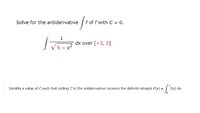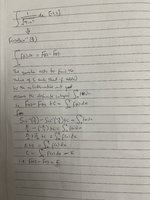Hi everyone, it's me again.
I just need an idea or call it a nudge in the right direction regarding finding a value for C such that adding C to the antiderivative recovers the definite integral `int` f(x) dx from a to x. I am a bit confused about what approach to use. It appears to me like Fundamental Theorem of Calculus part 2 but it's just not adding up. I have the derivative and the integral but to get the C is the problem.
The problem is solve for antiderivative f of f with C=0. `int` 1/`sqrt`(9-x^2) [-3,3]. I got the antiderivative as sin^-1(`x/3`)
The other question is the problem right now i.e. find a value for C such that adding C to the antiderivative recovers the definite integral \"int" \ f(x) dx from a to x
I will appreciate an idea.
I hope the questions are clear enough.
Thank you.
PS: I really have not done anything meaningful on the second part of the question so nothing copy and attach.
I just need an idea or call it a nudge in the right direction regarding finding a value for C such that adding C to the antiderivative recovers the definite integral `int` f(x) dx from a to x. I am a bit confused about what approach to use. It appears to me like Fundamental Theorem of Calculus part 2 but it's just not adding up. I have the derivative and the integral but to get the C is the problem.
The problem is solve for antiderivative f of f with C=0. `int` 1/`sqrt`(9-x^2) [-3,3]. I got the antiderivative as sin^-1(`x/3`)
The other question is the problem right now i.e. find a value for C such that adding C to the antiderivative recovers the definite integral \"int" \ f(x) dx from a to x
I will appreciate an idea.
I hope the questions are clear enough.
Thank you.
PS: I really have not done anything meaningful on the second part of the question so nothing copy and attach.
Last edited:





